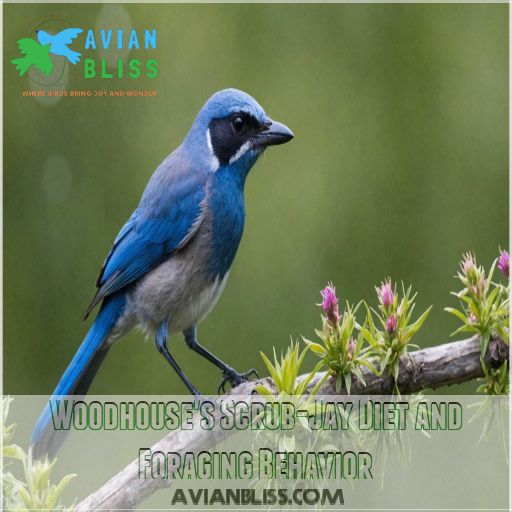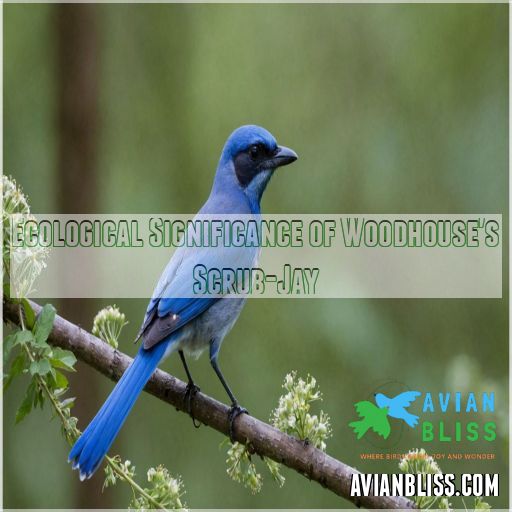This site is supported by our readers. We may earn a commission, at no cost to you, if you purchase through links.

These jays are like mini avian Einsteins, known for their intelligence and knack for food caching—imagine them as feathery treasure hunters.
Thriving from Nevada to Mexico, they charismatically chatter their way through life’s dramas, quickly adapting to forests and your backyard alike.
Whether they’re spreading seeds like little forest gardeners or outsmarting rival birds, they’re an essential part of the ecosystem.
Curious about their secret tricks to outsmart the seasons and competitors? Stick around for more on their fascinating behavior!
Table Of Contents
- Key Takeaways
- Woodhouse’s Scrub-Jay: Characteristics and Identification
- Habitat and Range of Woodhouse’s Scrub-Jay
- Woodhouse’s Scrub-Jay Diet and Foraging Behavior
- Social Structure and Breeding Habits
- Ecological Significance of Woodhouse’s Scrub-Jay
- Frequently Asked Questions (FAQs)
- What is the difference between California scrub jay and Woodhouse’s scrub-jay?
- Where do woodhouse scrub-jays live?
- What is the difference between Mexican jays and woodhouse scrub-jays?
- What do Woodhouse’s scrub-jays eat?
- How long do Woodhouses Scrub-Jays live?
- Do Woodhouses Scrub-Jays migrate or are they year-round residents?
- What are the main threats to Woodhouses Scrub-Jays?
- How do Woodhouses Scrub-Jays interact with other bird species?
- What conservation efforts are in place for Woodhouses Scrub-Jays?
- Conclusion
Key Takeaways
- You won’t find many birds as clever as Woodhouse’s Scrub-Jay, which acts like a feathered treasure hunter. These avian einsteins store food for lean times, showing off their impressive memory as they hunt for snacks they’ve squirreled away.
- Spotting a Woodhouse’s Scrub-Jay is like finding a dusty gem among birds. Their muted blue and gray plumage sets them apart from their brighter relatives, with unique features like a long tail and a straight, pointed bill—perfect for cracking open delectable treats.
- These jays are not only nature’s own gardeners, but also social creatures. They spread seeds across the landscape, unintentionally planting future forests, and even team up with other species, like mule deer, to exchange benefits. It’s a natural sitcom with plenty of drama!
- Despite not migrating, Woodhouse’s Scrub-Jays adapt beautifully to human environments, from backyards to golf courses. They’re like dependable, quirky neighbors, enjoying each season in the Southwest with resilience, a keen eye for opportunity, and a knack for blending into the scene.
Woodhouse’s Scrub-Jay: Characteristics and Identification
You’re about to meet one of nature’s most clever tricksters: the Woodhouse’s Scrub-Jay.
This dusty blue bird with its distinctive features and mischievous personality is a true character of the southwestern United States, and we’ll show you how to spot one in the wild.
Distinctive Physical Features
You’ll spot a Woodhouse’s Scrub-Jay by its distinctive shape and size.
This feathered friend stands out with:
- A long, slender tail that seems to defy gravity
- A slightly hunched-over posture, like it’s always ready for action
- A straight, pointed bill perfect for nut-cracking adventures
Its overall build screams "clever trickster" of the bird world.
Coloration and Plumage Details
Spotting the Woodhouse’s Scrub-Jay is like finding a dusty blue gem. Its plumage features various shades of gray and blue, depending on age and region. These birds flaunt a subtle palette that brightens backyard or woodland scenes, adding beauty to their bird habitat.
Plumage Variations are dependent on several factors, including age and region.
Juvenile Plumage is often gray and duller than adults.
Molting Patterns are seasonal and annual, with a gradual shift in plumage.
| Plumage Variations | Juvenile Plumage | Molting Patterns |
|---|---|---|
| Dusty Blue | Grayer | Seasonal |
| Gray-Brown | Duller Blue | Annual |
| Whitish Throat | Less White | Gradual Shift |
| Gray Belly | Paler Belly | Incremental |
| No Necklace | Spotty Throat | Fluctuating |
Comparison With Similar Jay Species
Compared to its cousins, Woodhouse’s Scrub-Jay stands apart with its dimmer blue hue and uniform gray-brown tones.
Unlike the vibrant California Scrub-Jay, this bird lacks a distinct necklace and boasts a straighter, pointed bill.
- Duller blue plumage than California Scrub-Jay
- Uniform gray-brown coloring, no bright contrasts
- Straight, pointed bill shape
- Lacks the prominent necklace of California cousin
Vocalizations and Calls
Often, the Woodhouse’s Scrub-Jay’s vocalizations include calls full of character and complexity.
These clever birds employ different call types:
| Call Type | Purpose | Example Sound |
|---|---|---|
| Alarm | Warning of danger | Sharp screech |
| Courtship | Attracting a mate | Soft, sweet notes |
| Territory Defense | Claiming space | Quick, harsh squawks |
Listening to their repertoire is like tuning into the chatter of a colorful avian soap opera!
Habitat and Range of Woodhouse’s Scrub-Jay
As you explore the habitat and range of Woodhouse’s Scrub-Jay, imagine this resourceful bird thriving in picturesque pinyon-juniper and oak-pinyon forests stretching from the Southwest to Mexico.
Adaptable and clever, these jays have no qualms about making themselves at home in your backyard while keeping other scrub-jays at bay.
Preferred Ecosystems and Vegetation Types
Amidst pinyon-juniper forests and oak woodlands, Woodhouse’s Scrub-Jays make their homes.
They thrive in desert scrub and riparian areas, even frequenting human-modified landscapes.
Like houseguests overstaying their welcome, these dynamic habitats offer food and company, like the ever-watchful western bluebird.
Life’s truly a buffet!
Geographic Distribution in North America
Woodhouse’s scrub-jays roam far and wide, from Nevada down to Mexico.
These adaptable birds thrive in diverse habitats – from pinyon-juniper forests to desert scrublands.
Their range has even expanded northward, thanks to their ability to coexist with humans.
Adaptation to Human-Modified Environments
Amidst urbanization and habitat loss, Woodhouse’s Scrub-Jay showcases impressive adaptability.
You might spot them:
- Competing for food at feeders
- Embracing human presence
- Nurturing tolerance in bustling backyards
- Exploring parks and golf courses
This vibrant jay cleverly thrives, despite human encroachments.
Seasonal Movement Patterns
You won’t find these jays migrating far, but they do shift within their territory based on food availability and seasonal needs.
| Season | Behavior | Habitat |
|---|---|---|
| Spring | Breeding | Pinyon Forest |
| Summer | Foraging | Mixed Woodlands |
| Fall | Flocking | Oak Savannas |
| Winter | Caching | Suburban Areas |
Even jays know the secret to happiness: home is where the food is!
Woodhouse’s Scrub-Jay Diet and Foraging Behavior
You’ll find that Woodhouse’s Scrub-Jay is an omnivore with a taste as diverse as its vivid plumage, thriving on nuts and seeds in colder months and insects in summer.
Its impressive food-storing habits might remind you of that one friend who stocks up for a zombie apocalypse!
Seasonal Dietary Variations
As the seasons change, Woodhouse’s scrub-jays adapt their diets accordingly.
In spring and summer, they feast on a bounty of insects and spiders, while the colder months see them shift to a hearty menu of nuts, seeds, and even small animals.
This versatile diet helps these clever birds thrive year-round, thanks to their ability to find food in a variety of environments. their diverse diet.
Food Caching Techniques
Squirreling away food, Woodhouse’s Scrub-Jay masters food caching strategies for winter survival.
With a remarkable memory for cache locations, it navigates food competition by burying snacks.
Each cache retrieval mirrors treasure hunting, ensuring they never go hungry—even during the iciest days of winter.
Foraging Strategies and Adaptations
Mastering their environment like nature’s own strategists, Woodhouse’s Scrub-Jays showcase impressive foraging adaptations.
Their approach includes:
- Food caching for leaner times
- Utilizing thin, pointed bills for pine nuts
- Adjusting to a seasonal diet
They also demonstrate:
- Quick adaptation to habitat changes
- Outmaneuvering competition with intelligence
Interactions With Other Species While Feeding
You might spot Woodhouse’s Scrub-Jays in a lively café of nature, juggling interactions with various species. Their social dominance shows in food competition, while predator avoidance is excellent. Occasionally, mutualism blooms with mule deer, creating interspecies communication moments that would make nature’s sitcoms bow in awe.
| Interaction | Species Involved | Result | Example |
|---|---|---|---|
| Food Competition | Other Birds | Decreased Resources | Seeds and Nuts |
| Predator Avoidance | Birds of Prey | Survival Advantage | Quick Escape |
| Mutualism | Mule Deer | Benefit Exchange | Tick Removal |
| Interspecies Communication | Clark’s Nutcrackers | Shared Foraging Info | Acorn Locations |
Social Structure and Breeding Habits
Woodhouse’s scrub jays are devoted partners, sticking together year-round and even feeding each other.
They are also fiercely defensive of their territory, chasing away any other scrub jays that dare to encroach on their domain.
Pair Bonding and Territorial Behavior
Among Woodhouse’s Scrub-Jays, lovebirds are pros at partnership.
During breeding season, these charming jays form lifelong bonds, choosing mates and fiercely guarding their slice of habitat.
Much like an old married couple, they stick together, defending territory with an impressive display of teamwork.
Nest Construction and Site Selection
Imagine building a dream home—a thick-walled, cozy nest—like a clever architect! Choose the right site and nest materials:
- Twigs and grasses for sturdiness
- Lining of rootlets for comfort
- Defense from predators
- Well-spaced nesting density
- High success rate
These choices help guarantee safety and success!
Breeding Season and Reproductive Cycle
The breeding season, full of charismatic antics, showcases Woodhouse’s Scrub-Jay’s knack for partnership.
These playful birds engage in elaborate mating rituals before nest building begins before nest building begins.
Egg laying follows, and the female dutifully incubates.
Their teamwork helps the chicks succeed in life’s unpredictable landscape.
Parental Care and Fledgling Development
Once the chicks hatch, devoted Woodhouse’s Scrub-Jay parents take charge.
They:
- Diligently feed the nestlings
- Teach fledglings to forage and fly
- Fiercely defend the brood from predators
- Adjust care based on brood size
- Manage sibling squabbles with patience
This hands-on approach helps the young jays thrive and carry on the species’ clever legacy.
Ecological Significance of Woodhouse’s Scrub-Jay
Discover the ecological marvels of Woodhouse’s Scrub-Jay as it acts like nature’s gardener by dispersing seeds and warding off pesky insects with flair.
This bird’s love of acorns isn’t just about snacking—it’s about planting the future, even if it means risking a squabble with a nearby farmer.
Role in Seed Dispersal and Forest Regeneration
Woodhouse’s Scrub-Jays, as you’d expect, are nature’s gardeners, spreading seeds wide and far.
Their seed caching behavior turns them into mini forest regenerators.
These jays, in their wise blue ways, help new woodland growth, while their playful antics provide high-flying entertainment for onlookers.
Everyone wins!
Impact on Insect Populations
Ever find yourself wishing for fewer garden pests? Woodhouse’s Scrub-Jay might just be your backyard hero.
These clever birds play an essential role in insect control by hunting pesky bugs.
Their predation impact helps maintain balanced pest populations, offering beneficial effects for natural pest management.
Interactions With Agricultural Systems
Woodhouse’s Scrub-Jays can be a mixed blessing for farmers. While they help control insect pests, their fondness for nuts and fruits can negatively impact crop yields, especially in orchards. Growers must find a balance – these clever birds play a key role in seed dispersal and forest health.
- Crop Damage: Woodhouse’s Scrub-Jays have a penchant for nuts, seeds, and fruits, which can lead to losses in orchards and farms.
- Orchard Impact: Their foraging habits can disrupt harvests, as they pluck and cache produce before it’s ready for picking.
- Pest Control: On the flip side, these birds prey on insects like ticks and flies, providing natural pest management services.
- Seed Dispersal: By burying and forgetting food caches, Woodhouse’s Scrub-Jays inadvertently spread seeds, contributing to forest regeneration.
Conservation Status and Population Trends
Facing the challenges of climate change and human impact, Woodhouse’s Scrub-Jay population trends suggest it’s a resilient charmer.
Habitat loss poses challenges, yet these clever birds adapt ingeniously.
Conservation efforts focus on preserving their woodland homes, ensuring these avian jesters keep forest ecosystems vibrant and entertaining.
Frequently Asked Questions (FAQs)
What is the difference between California scrub jay and Woodhouse’s scrub-jay?
When you compare them, the California Scrub-Jay is the flashier sibling, flaunting brighter blue plumage and a distinct necklace.
Meanwhile, Woodhouse’s Scrub-Jay opts for muted colors and lacks a necklace, emphasizing subtlety over showiness.
Where do woodhouse scrub-jays live?
You’ll find these feathery adventurers spread across the Southwest, from Nevada to Mexico, hanging out in low scrub and pinyon-juniper forests.
They’re also fond of backyards, parks, and even golf courses, enjoying their own tiny territory.
What is the difference between Mexican jays and woodhouse scrub-jays?
Mexican Jays sport a uniform blue body with a paler underside, unlike the Woodhouse’s Scrub-Jays, which have a light blue and gray top with a gray belly.
Mexican Jays often form larger flocks, echoing camaraderie in nature.
What do Woodhouse’s scrub-jays eat?
You’ll find these clever birds snacking on a variety of foods, from insects and spiders in summer to nuts and seeds in colder months.
They’ll even nab small lizards, snails, and baby birds!
Woodhouse’s scrub-jays are true omnivores.
How long do Woodhouses Scrub-Jays live?
Woodhouse’s Scrub-Jays can live up to about 9 years in the wild.
Think of them as those old, wise, feathered friends, sticking around long enough to scatter seeds, crack a few pine nuts, and share tales.
Do Woodhouses Scrub-Jays migrate or are they year-round residents?
These scrub-jays are like your dependable neighbors; they’re year-round residents and don’t migrate.
You’ll find them hanging around their favorite spots in the Southwest, enjoying each season with their distinctive blue-gray style and lively antics.
What are the main threats to Woodhouses Scrub-Jays?
Threats include habitat destruction from urban expansion, climate change altering their environment, and West Nile virus.
They might lose their favorite pine-nut restaurants and stainless-steel bill gas stations.
Let’s hope they continue hopping along with resilience!
How do Woodhouses Scrub-Jays interact with other bird species?
You’ll be amazed to learn that Woodhouse’s Scrub-Jays are quite the social butterflies!
They’ve been spotted standing on deer, picking off ticks and parasites – the deer seem to appreciate the help, allowing the jays access.
What a mutually beneficial relationship!
What conservation efforts are in place for Woodhouses Scrub-Jays?
Conservation for Woodhouse’s Scrub-Jays emphasizes habitat preservation, especially their beloved pinyon-juniper woodlands.
Protecting these environments supports not just jays, but diverse flora and fauna.
Engage in local efforts, fostering their harmony with nature’s rich tapestry.
Conclusion
Ever wonder how the Woodhouse’s Scrub-Jay manages to stay a step ahead in nature’s game?
With their clever tricks, these jays prove themselves as remarkable seed dispersers but also as intelligent adapters who thrive in various habitats, including your backyard like their corvid cousins.
Understanding their role in the ecosystem deepens our appreciation for these avian Einsteins.
So, next time you spot one, take a moment to admire this crafty creature’s contribution to nature’s balance. They’re more than just a colorful bird!








